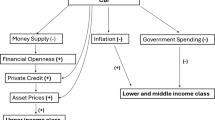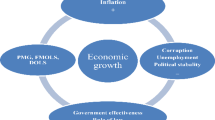Abstract
This paper starts by separating the transformational recession (reduction of output in most transition economies in the first half of the 1990s) from the process of economic growth (recovery from the transformational recession) in 28 transition economies (including China, Vietnam and Mongolia). It is argued that the former (the collapse of output during transition) can be best explained as adverse supply shock caused mostly by a change in relative prices after their deregulation due to distortions in industrial structure and trade patterns accumulated during the period of central planning, and by the collapse of state institutions during transition period, while the speed of liberalisation, to the extent it was endogenous, that is, determined by political economy factors, had an adverse effect on performance. In contrast, at the recovery stage the ongoing liberalisation starts to affect growth positively, whereas the impact of pre-transition distortions disappears. Institutional capacity and reasonable macroeconomic policy, however, continue to be important prerequisites for successful performance.









Similar content being viewed by others
Notes
3 While Vietnamese industry, excluding constantly and rapidly growing oil production, experienced some downturn in 1989–1990 (−6% in 1989 and 0% in 1990) agricultural growth remained strong, so that GDP growth rates virtually did not fall (5%–6% a year).
5 Total output consists of output of competitive and non-competitive sectors: Y n =(Y n C+Y n NC) and is equal to 1 or 100% in the initial year. Output in the non-competitive sector in the year n, Y n NC, is equal to the share of the non-competitive sector in total output in the initial year, NC, multiplied by (1–α)n, where α is the rate of reduction of output in the non-competitive sector determined by the speed of deregulation: Y n NC=(1–α)n*NC. Output in the competitive sector in the year n is equal to the output of the preceding year, Yn–1C, plus the increase in output equal to marginal capital productivity, a, multiplied by the share of net investment in GDP, s, multiplied by total output:
 . Solving for total output, we get:
. Solving for total output, we get:  .
.6 The problem is still there for many transition economies, since many domestic price ratios are quite different from those of the world market. Fuel and energy prices, for instance, in most cases are still way below the world market prices. To cite one example, in Russia electricity tariffs at the end of the 1990s were about 1 US cent per kw-h, whereas in Western and even in Central European countries, they amounted to 10 cents (EBRD, 2001). Meanwhile, the third most important Russian export commodity (after oil and gas) was extremely energy-intensive aluminum, produced out of largely imported bauxite. If Russian electric energy prices are increased to the world level instantly, investment required to create jobs just for the workers of going out of business aluminum smelters and other energy-intensive enterprises may exceed the meager investment potential of the whole national economy.
7 The cumulative decline of output for many countries is higher than 100% because the output losses for a number of years are summed up. For China and Vietnam, the cumulative decline in output is negative, that is, should be interpreted as cumulative gain in GDP for the period.
8 In Vietnam, economic reforms started in 1986 (‘don moi’ course), they resembled very much Gorbachev-type marginal reforms in the same period, and it was not until 1989 that most prices were deregulated that caused some reduction of output in non-oil industry, but not in other sectors, so GDP growth rates did not decline.
9 The level of the liberalisation by 1995 is negatively correlated with the increase of the liberalization index in 1995–2003, so both indices cannot be included into the same regression (when both are included, one or both become insignificant).
10 This is consistent with the result obtained by Popov (2000) and Godoy and Stiglitz (2004).
11 The number of observations in this case is only 17 (lack of data on shadow economy). Because the increase in the share of shadow economy is strongly correlated with the decline in the ratio of government revenues to GDP (Popov, 2000), these two indicators are included into the right-hand side of the equation separately (to avoid multicolinearity).
12

N=442 (17 years and 26 countries), R2=23, T-statistics in brackets. FOC allows to determine the exact year of the minimum – it is 1996–1997.
References
Atkeson, A and Kehoe, PJ . 1996: Social insurance and transition. International Economic Review 37: 377–402.
Blanchard, O and Kremer, M . 1997: Disorganization. The Quarterly Journal of Economics (MIT Press) 112 (4): 1091–1126.
Campos, N . 2000: Context is Everything: Measuring Institutional Change in Transition Economies. Policy Research Working Paper Series No. 2269, The World Bank.
De Melo, M, Denizer, C, Gelb, A and Tenev, S . 1997: Circumstance and Choice: The Role of Initial Conditions and Policies in Transitions Economies. The World Bank. Policy Research Working Paper Series No. 1986.
De Melo, M, Denizer, C and Gelb, A . 1996: Patterns of transition from plan to market. World Bank Economic Review 3: 397–424.
Denizer, C, Gelb, A, De Melo, M and Tenev, S . 2001: Circumstance and choice: The role of initial conditions and policies in transition economies. World Bank Economic Review 15 (1): 1–31.
EBRD. 1999: Transition Report, 1999.
EBRD. 2001: Transition Report, 2001.
Friedman, EJ and Johnson, S . 1995: Complementarities and Optimal Reform, Working paper no.109, Stockholm Institute of East European Economics, December, 1995.
Godoy, S and Stiglitz, J . 2004: Growth, initial conditions, law and speed of privatization in transition countries: 11 years later. Mimeo, 2004 (http://www2.gsb.columbia.edu/faculty/jstiglitz/download/website/Growth_Initial_Conditions_Law_and_Speed.htm).
Havrylyshyn, O and van Rooden, R . 2003: Institutions matter in transition, but so do policies. Comparative Economic Studies 45 (1): 2–24.
Heybey, B and Murrell, P . 1999: The relationship between economic growth and the speed of liberalization during transition. Journal of Policy Reform 3 (2): 121–137.
Kaufmann, D and Kaliberda, A . 1996: Integrating the Unofficial Economy into the Dynamics of Post-Socialist Economies. Policy Research Working paper no. 1691. The World Bank: Washington, DC.
Kolodko, GW . 2000: From Shock to Therapy. Political Economy of Postsocialist Transformation. Oxford University Press: Oxford, NY.
Krueger, G and Ciolko, M . 1998: A note on initial conditions and liberalization during transition. Journal of Comparative Economics 26 (4): 618–634.
Lau, LJ, Qian, Y and Roland, G . 1997: Pareto-improving economic reforms through dual-track liberalization. Economic Letters 55: 285–292.
Li, W . 1996: A Tale of Two Reforms. The Importance of Initial Market Conditions. Duke University: Durham, NC.
Murphy, K, Shleifer, A and Vishny, RW . 1992: The transition to a market economy: Pitfalls of partial reform. Quarterly Journal of Economics 107 (3): 889–906.
Polterovich, V . and Popov, V . 2002: Accumulation of foreign exchange reserves and long term economic growth. In: Tabata S and Iwashita A. (eds). Slavic Eurasia's Integration into the World Economy. Slavic Research Center, Hokkaido University: Sapporo. See full version at: http://www.nes.ru/english/research/pdf/2003/PopovPolterovich.doc; http://www.nes.ru/english/about/10th-Anniversary/papers-pdf/Popov-Polterovich.pdf and http://www.nes.ru/english/about/10th-Anniversary/papers-pdf/Popov-charts.pdf.
Polterovich, V . and Popov, V . 2004: Appropriate Economic Policies at Different Stages of Development. NES, 2004 (http://www.nes.ru/english/research/pdf/2005/PopovPolterovich.doc). The updated version: http://www.wider.unu.edu/conference/conference-2005-3/conference-2005-3.htm.
Polterovich, V. and Popov, V . 2005: Democracy and growth reconsidered: Why economic performance of new democracies is not encouraging. (http://ctool.gdnet.org/conf_docs/PopovDemocracy2004Aug.doc and http://ctool.gdnet.org/conf_docs/PopovDemocracy-charts%202004.xls).
Popov, V . 2000: Shock therapy versus gradualism: The end of the debate (explaining the magnitude of the transformational recession). Comparative Economic Studies 42 (1): 1–57.
Popov, V . 1998: Investment in transition economies: Factors of change and implications for performance. Journal of East–West Business 4 (1/2): 47–98.
Roland, G . 2000: Transition and Economics. Politics, Markets and Firms. The MIT Press: Cambridge, MA.
Roland, G and Verdier, T . 1999: Transition and output fall. Economics of Transition 7 (1): 1–28.
World Bank. 1996: From Plan to Market. World Development Report. Oxford University Press: Oxford, NY.
Zakaria, F . 1997: The rise of illiberal democracies. Foreign Affairs 76 (6): 22–43.
Author information
Authors and Affiliations
Additional information
This paper is the logical continuation of my earlier article in Comparative Economic Studies 2000: 42(1, Spring): 1–57. The arguments of this earlier article, however, are reconsidered in light of new research and evidence. I am grateful to Barry Ickes, Jeffrey Miller, Gur Ofer, Victor Polterovich and the anonymous referee for the comments.
2 For a larger sample of countries (all developing and developed countries, not only transition economies), the result is that there is a threshold level of the rule of law index: if it is higher than a certain level, democratization affects growth positively, if lower – democratization impedes growth (Polterovich and Popov, 2005). For the regressions reported in Table 1 (to explain changes in output in 1989–1996), averages of rule of law and democracy indices were used for the longer period (1989–1998) to account for the fact that business agents often anticipate changes in business climate that are captured in experts’ estimates only later.
Appendix A. Determining the year of the end of the recession and the start of the recovery
Appendix A. Determining the year of the end of the recession and the start of the recovery
The determination of the exact date of the trough of the downturn and the start of recovery for all 26 countries that experienced transformational recession (China and Vietnam are excluded from the sample) poses some problems. Assigning a specific trough for each and every country is problematic because the cross-country comparison in this case will ignore the length of recession (which lasted from 2 years in Poland to 10 years in Moldova – see Figures A1).
Formal methods to determine a single year for all countries give different results. The unweighted average of GDP indices for 26 countries bottoms out in 1994, whereas the parabolic approximation of panel data (GDP by year and by country as a percentage of the 1989 level) determines the year of the bottom of the recession as between 1996 and 1997Footnote 10 (Figure 1A). The use of more sophisticated methods of finding the structural break in the series is also questionable: the choice of any single year will overestimate the length of the recession in some countries and/or underestimate the length of the recession in the other.
Hence, the approach chosen in this paper is to use several alternative years of the end of the recession and the start of the recovery and to show that the results hold, no matter which particular year is chosen. For the recession trough 1996 and 1998 were used, so the periods considered were 1989–1996 and 1989–1998. The absolute trough was reached before the end of 1994 in 14 countries out of 26, by the end of 1996 in 21 countries, and by the end of 1998 in 24 countries. For the start of the recovery, the year 1994 was used in the earlier article (Popov, 2000), so the period considered was 1994–1998. In the current article, the years 1995 and 1998 were assumed to be the start of the recovery and three periods were considered – 1995–2003, 1995–2005 and 1998–2005. The results were generally unchanged, but weakened somewhat when the period of recession was stretched forward by 2 years (from 1989–1996 to 1989–1998) and when the period of the beginning of recovery was stretched backwards (from 1998 to 1995). The best results were obtained for the recession period 1989–1996 and for the recovery period 1998–2005, which is quite consistent with intuition.
Rights and permissions
About this article
Cite this article
Popov, V. Shock Therapy versus Gradualism Reconsidered: Lessons from Transition Economies after 15 Years of Reforms. Comp Econ Stud 49, 1–31 (2007). https://doi.org/10.1057/palgrave.ces.8100182
Published:
Issue Date:
DOI: https://doi.org/10.1057/palgrave.ces.8100182





 . Solving for total output, we get:
. Solving for total output, we get:  .
.
